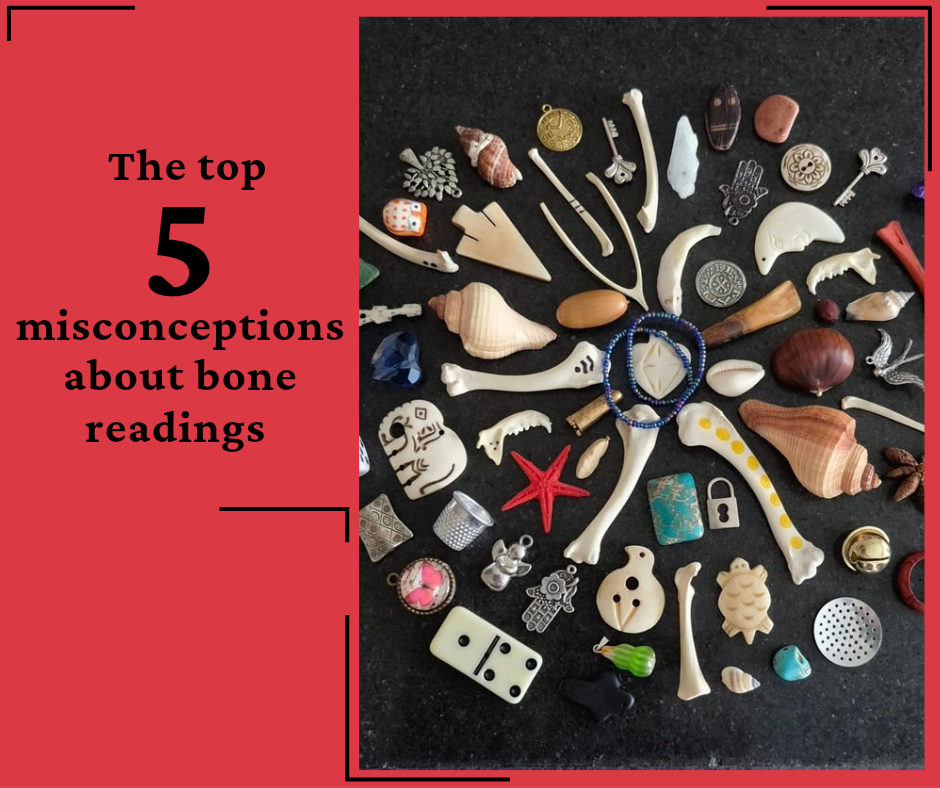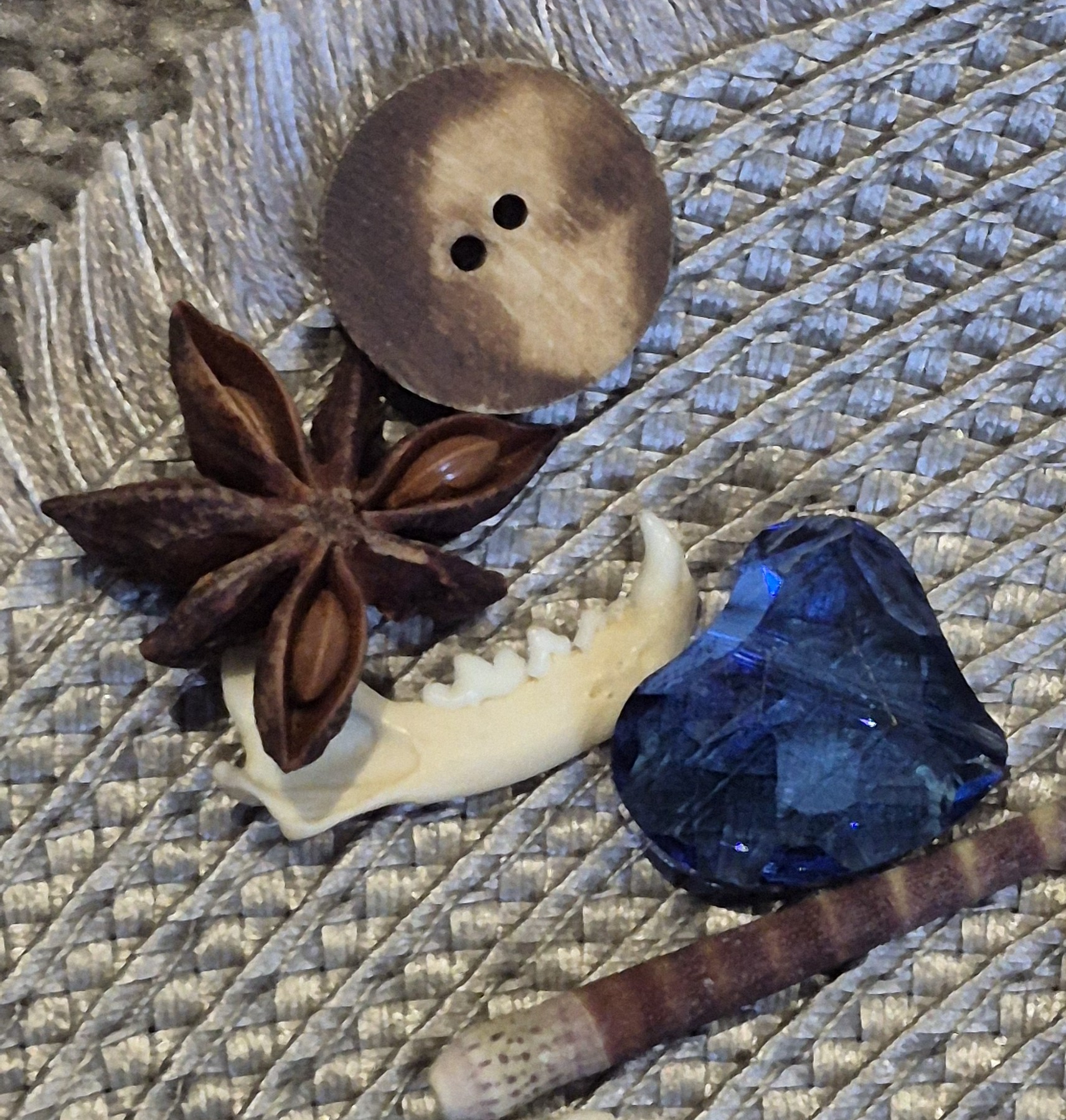
Bone reading has become better known as a divination practice since I began reading with my bone reading set circa 2017-2018… But despite its increasing popularity, it still remains one of the most misunderstood divination practices today. People see bones, shells, and curious objects scattered across a cloth and assume it’s all smoke and mirrors. Or they think you need special powers passed down through generations.
The truth? Quite a lot of what you’ve heard about bone reading is probably wrong.
Let’s clear up the five biggest myths that I have personally heard, which keep people from exploring this ancient practice.
Misconception #1: Bone Reading Requires Psychic Powers or a Special Birthright
Here’s one big lie about bone reading: you either have “a gift” or you don’t.
That’s nonsense.
Anyone can learn bone reading. It’s a skill, like painting or playing guitar. You won’t master it overnight, but you don’t need to be born with magic in your veins either.
Many successful bone readers started as total beginners. They had no prior experience with divination. No psychic moments as children. No family history of spiritual work. They simply felt drawn to the practice and put in the time to learn.
What many people call “psychic ability” is often just highly developed intuition. We all have it. Most of us ignore it. Bone readers learn to listen to those quiet inner voices and trust what they sense.
That connection between reader and bones grows stronger with practice. The first few times you cast bones, you might feel lost. A month later, patterns start making sense. A year in, you’re reading the bones like an old friend’s handwriting.
Knowledge isn’t locked away either. Books exist. Teachers offer guidance. Online communities share wisdom freely. You can learn the history, symbolism, and techniques if you’re willing to study.
Misconception #2: Only Certain Ethnicities Can Practice Bone Reading
This myth needs to die fast.
The concept of using bones to interpret messages from the otherworld, our ancestors, or our Gods isn’t owned by any one culture. Humans across the planet developed bone divination independently. African traditions include the powerful practices of Sangomas in Southern Africa. Mongolians read shagai (ankle bones). Ancient Romans practiced astragalomancy, and my Scottish ancestors would have been familiar with reading the shoulderblades of Oxen . Indigenous peoples across multiple continents created their own systems.
The real question isn’t “Can I practice this?” It’s “Am I practicing this respectfully?”
“But what if it’s a closed practice?”
Who is saying that bone reading, as a divination system, is closed? Teenagers on the Internet?
Listen: If you want to practice bone reading as part of an initiatory practice (e.g. training as a Sangoma), you will need to earn your place within that tradition, this is true. But you dont need to be initiated into a given tradition to put together a set that is unique to you and learn to read with bones. Funnily enough, some of the loudest gatekeepers that I’ve encountered aren’t always initiated into the traditions they claim to be defending, but are still happy to speak for another group of people (and the spirits they work with) because they live in a specific country, are a particular ethnicity, etc.
There’s a difference between cultural appreciation and cultural theft. If you’re drawn to a specific tradition, learn its origins. Understand its context. Give credit where it’s due. Don’t claim to be something you’re not.
Be honest about your background. If you’re studying African bone reading traditions, say so, and consider seeking legitimate initiation into a given tradition. Don’t pretend you inherited the knowledge or make up a spiritual lineage.
Many modern practitioners create eclectic systems. They blend elements from multiple traditions or build something entirely new. The divination community generally supports this as long as you’re transparent and respectful.
Your personal connection to the practice matters. Your ethics matter. Your ethnicity? Not quite the barrier people think it is.
Misconception #3: All Bones in a Set Should Be Real, Natural Bones
The name “bone reading” confuses people.
Most sets contain way more than bones. Shells, stones, coins, beads, buttons, and charms appear in traditional and modern collections alike. The word “bones” refers to the practice itself, not a strict material requirement.
Real animal bones work beautifully. But they’re not mandatory.
Modern readers have good reasons to use alternatives. Ethical concerns about animal remains matter to many practitioners and access to them can be an issue. Not everyone can source real bones safely or legally.
Resin replicas can work just fine, carved wood can also work well. What matters is the intention you put into your tools and the relationship you build with them.
Through use and consecration, any object becomes spiritually significant. While a plastic token might not hold energetic imprints well, there’s always the possibility that a plastic or resin item that you’ve worked with for years can speak louder than an “authentic” bone you just bought.
The symbolism in your system beats material purity, so if a blue glass bead represents water in your practice, it works.
Your set should reflect your practice, your values, and what resonates with you. Real bones are wonderful to work with but don’t have to make up 100% of your set.
Misconception #4: You Need to Work with All of Your Ancestors to Receive or Use a Bone Reading
This assumption causes real harm.
Bone reading can work independently from ancestor worship. Many practitioners connect with their ancestors, but you could connect with spirit guides, deities, or universal wisdom instead.
The bones don’t require a family reunion to function.
Even practitioners who do ancestral work don’t have to call on everyone. You can work with “benevolent ancestors” the wise and healed spirits who want to help and can also focus on spiritual ancestors like teachers and mentors rather than blood relations.
Not all family lines are healthy, so some lineages carry trauma, abuse, or hatred within them. You’re not obligated to maintain spiritual ties with toxic energies just because you share DNA.
This matters for all sorts of people with painful family histories:
- Adoptees.
- Survivors of family violence.
- People whose ancestors held harmful beliefs.
You don’t have to allow such ancestors access to yourself or your practices, because healthy boundaries in spiritual work are vital. You’re allowed to choose which relationships feel safe and supportive and the effectiveness of your readings doesn’t depend on forgiving the unforgivable or inviting harmful spirits to the table.
Your practice, your rules.
Misconception #5: Every Bone Reading Set Is, or Should Be, the Same
Walk into a room of ten bone readers and you’ll see ten different sets.
Some people work with tiny collections of four to seven pieces. Others spread out fifty or more objects. Neither approach is wrong. The right size depends on your reading style and how much information you can track at once.
The meanings vary wildly too. One reader’s “love” bone might represent romance, with other bones in the set pointing to the what, where, and who of it all. Another’s might cover all forms of connection, but fall in a specific place on their may to indicate a romantic interest. A third reader might use that same piece for passion or desire.
Aside from certain bones typically meaning certain things within a specific tradition, there’s no official bone reading dictionary. You create your own symbolic language through intuition and experience. What works for someone else might feel completely wrong to you.
Sets also change over time. Beginners often start simple and add complexity as they grow. You might include a new piece after a major life shift. Remove one that no longer speaks to you. Replace items that break or get lost.
Seasonal changes can inspire updates. So can new spiritual insights. Your set is alive, growing with you as you deepen your practice.
The goal isn’t to build a perfect, finished collection. It’s to maintain tools that accurately reflect your current spiritual state and divination needs.
Your bones will never look exactly like someone else’s (and that’s exactly how it should be).
The Bottom Line
Bone reading isn’t what most people think.
You don’t need special powers. Your ethnicity doesn’t bar you from learning. Real bones are optional. Ancestor work isn’t required. And there’s no standard set you must copy.
The practice is accessible, personal, and flexible. It welcomes anyone willing to approach it with respect and genuine interest.
If you feel called to bone reading, trust that pull. Start small. Read widely. Find teachers or communities, if you can. Gradually build a set that feels right to you.
The bones don’t demand perfection. They ask for honesty, patience, and an open heart.
That’s something anyone can offer.

